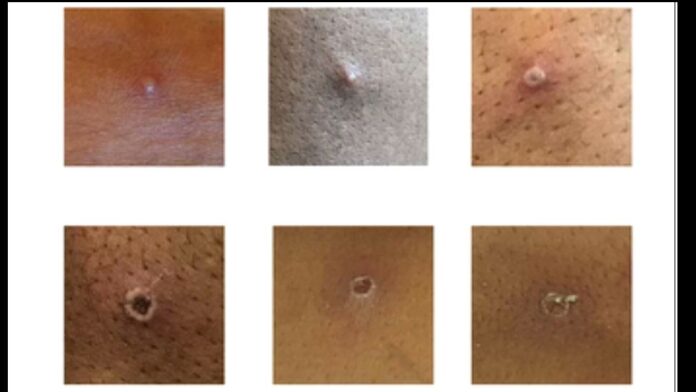Monkeypox Virus Infection in the United States and Other Nonendemic Countries—2022
As of June 1st, 2022, the US is reporting 18 cases of monkeypox: California (3), Colorado (2), Florida (3), Georgia (1), Massachusetts (1), New York (4), Utah (2), Virginia (1) and Washington (1).
Texas does not have a confirmed case of monkeypox currently. The Centers for Disease Control and Prevention (CDC) and the Texas Department of State Health Services (DSHS), along with local and regional public health departments are investigating persons with suspicion of monkeypox to determine whether they meet case definitions and are monitoring anyone with reported contact with confirmed cases.
Cases of monkeypox have previously been identified in travelers from, or residents of, West African or Central African countries where monkeypox is considered to be endemic. Texas DSHS is issuing this Health Alert Network (HAN) Health Advisory to ask clinicians in Texas to be vigilant for the characteristic rash associated with monkeypox.
Suspicion for monkeypox should be heightened if a rash concerning for monkeypox occurs in people who:
1) traveled to countries or states with recently confirmed cases of monkeypox,
2) report having had contact with a person or people who have a rash similar to monkeypox or who have received a diagnosis of confirmed or suspected monkeypox, or
3) is a man who regularly has close or intimate in-person contact with other men.
Lesions may be disseminated or located in the genital or perianal area alone.
Some patients may present with proctitis, and their illness could be clinically confused with varicella zoster virus infection or with a sexually transmitted infection (STI) like syphilis or herpes.
Monkeypox Background
Monkeypox disease symptoms always involve the characteristic rash, regardless of whether the rash is disseminated or localized. Historically, the rash has been preceded by a prodrome including fever, lymphadenopathy, and often other non-specific symptoms such as malaise, headache, and muscle aches.
In the most recently reported cases, prodromal symptoms may not have always occurred; some recent cases have begun with characteristic, monkeypox-like lesions in the genital and perianal region, in the absence of subjective fever and other prodromal symptoms. For this reason, cases may be confused with more commonly seen infections (e.g., syphilis, chancroid, herpes, and varicella zoster). The average incubation period for symptom onset is 7–14 days (range 5-21 days).
The typical monkeypox lesions involve the following: deep-seated and well circumscribed lesions, often with central umbilication; and lesions progress through specific sequential stages—macules, papules, vesicles, pustules, and scabs. Synchronized progression (and thus monkeypox lesions are typically all in a similar phase of progression)occurs on specific anatomic sites with lesions in each stage of development for at least 1–2 days.
The scabs eventually fall off. Lesions can occur on the palms and soles, and when generalized, the rash is very similar to that of smallpox including a centrifugal distribution. Monkeypox can occur concurrently with other non monkeypox rashes, including varicella-zoster virus and herpes simplex virus infections.
Case fatality for monkeypox is reported to range between 1 and 11% for previous outbreaks. Confirmatory laboratory diagnostic testing for monkeypox is performed using real-time polymerase chain reaction assay on lesion-derived specimens.
A person is considered infectious from the onset of symptoms and is presumed to remain infectious until lesions have crusted, those crusts have separated, and a fresh layer of healthy skin has formed underneath. Human to-human transmission occurs through large respiratory droplets and by direct contact with body fluids or lesion material.
Respiratory droplets generally cannot travel more than a few feet, so prolonged face-to-face contact is required. Indirect contact with lesion material through fomites, such as shared bed sheets, has also been documented. Animal-to-human transmission may occur through a bite or scratch, preparation of wild game, and direct or indirect contact with body fluids or lesion material.
There is no specific treatment for monkeypox virus infection, although antivirals developed for use in patients with smallpox may prove beneficial.
Persons with direct contact (e.g., exposure to the skin, crusts, bodily fluids, respiratory droplets or other materials) or indirect contact (e.g., presence within a six-foot radius in the absence of an N95 or filtering respirator for ≥3 hours) with a patient with monkeypox should be monitored by health departments; depending on their level of risk, some persons may be candidates for postexposure prophylaxis with smallpox vaccine under an
Investigational New Drug protocol after consultation with public health authorities.
If treatment is being sought, the attending physician, CDC, and DSHS Central Office epidemiologists must provide approval. Requests for patient treatment or for postexposure prophylaxis (PEP) must use the resource request through the State of Texas Assistance Request (STAR) process.
Recommendations for Clinicians
If clinicians identify patients with a rash that could be consistent with monkeypox, especially those with a recent travel history to a country or state where monkeypox has been reported, monkeypox should be considered as a possible diagnosis.
The rash associated with monkeypox can be confused with other diseases that are more commonly encountered in clinical practice (e.g., secondary syphilis, herpes, chancroid, and varicella zoster). Clinicians should be familiar with the typical presentation of
monkeypox.
However, a high index of suspicion for monkeypox is warranted when evaluating people with the characteristic rash, particularly for the following groups: men who report sexual contact with other men and who present with lesions in the genital/perianal area, people reporting a significant travel history in the 21 days before illness onset, or people
reporting contact with people who have a similar rash or have received a diagnosis of suspected or confirmed monkeypox. Immunocompromised patients may not have a typical presentation.
Clinicians should consult their local health department if they suspect monkeypox (Texas Local Public Health Organizations). If unable to make contact, please send an e-mail to (EAIDUMonitoring@dshs.texas.gov).
All specimens for monkeypox testing must be approved by the Texas Department of State Health Services before being sent to a Laboratory Response Network (LRN) laboratory. Testing for other more likely etiologies should continue as normal and not be delayed on the basis of testing for monkeypox.
Monkeypox Testing Procedures
Appropriately collected and approved samples can be sent to DSHS Laboratory or an appropriate LRN laboratory for testing by real-time PCR.
Laboratory Response Network laboratories can provide orthopoxvirus testing on lesion specimens that clinicians obtain from possible cases; confirmatory monkeypox virus-specific testing at CDC requires a dry lesion swab specimen. Collect multiple specimens of multiple types of lesions for preliminary and confirmatory testing as follows: 1) Vigorously swab or brush lesion with two separate sterile, dry polyester or Dacron swabs; 2) Break off
the end of the applicator of each swab into a 1.5- or 2-mL screw-capped tube with O-ring or place each entire swab in a separate sterile container. Do not add or store in viral or universal transport media.
Mild cases of monkeypox should generally be treated and isolated at home in consultation with state and local public health departments. However, in cases where hospitalization is required, the local hospital is expected to provide care. For infection control and PPE guidance, please visit https://www.cdc.gov/.
If monkeypox is suspected by a clinician or local health department (LHD), contact DSHS central office for testing approval (512-776-7676). If you have specific questions, please send them to the EAIDUmonitoring@dshs.texas.gov inbox for testing, monitoring, postexposure prophylaxis (PEP), and treatment.
Recommendations for the Public
Based on the evolving situation, risk to the general public appears low.
People who may have symptoms of monkeypox, such as the characteristic rash or lesions, should contact their healthcare provider for evaluation. This especially includes anyone who 1) has symptoms concerning for monkeypox who traveled to countries or states where monkeypox cases have been reported, 2) reports contact with a person who has a rash similar to monkeypox or who has received a diagnosis of confirmed or suspected
monkeypox, or 3) has symptoms concerning for monkeypox who is a man
who has had close or intimate in-person contact with other men in the past
month.
Current Clusters in Non-Endemic Countries
Since May 14, 2022, clusters of monkeypox cases have been reported in several countries that do not normally have monkeypox. Although previous cases outside of Africa have been associated with travel from endemic countries, most of the recent cases do not have direct travel-associated exposure risks.
The United Kingdom Health Security Agency (UKHSA) was the first to announce on May 7, 2022, identification of a recent U.K. case that occurred in a traveler returning from Nigeria.
On May 14, 2022, UKHSA announced an unrelated cluster of monkeypox cases in two people living in the same household who have no history of recent travel.
On May 16, 2022, UKHSA announced a third temporally clustered group of cases involving four people who self-identify as gay, bisexual, or men who have sex with men (MSM), none of whom have links to the three previously diagnosed patients.
Some evidence suggests that cases among MSM may be epidemiologically linked; the patients in this cluster in the U.K. were identified at sexual health clinics. This is an evolving investigation and public health authorities hope to learn more about routes of exposure associated with the current outbreak.
Monkeypox is a zoonotic infection endemic to several Central and West African countries. The wild animal reservoir is unknown. Before May 2022, cases outside of Africa were reported either among people with recent travel to endemic countries or contact with a person with a confirmed monkeypox virus infection.
However, in May 2022, nine patients were confirmed with monkeypox in England; six were among persons without a history of travel to Africa and the source of these infections is unknown. To date, 183 cases have been confirmed in the UK.













